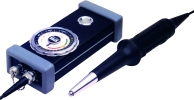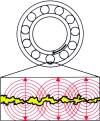Condition monitoring: modern answers - age-old methods, Part 2
July 2006
Maintenance, Test & Measurement, Calibration
In the June 2006 issue of SAI&C, we looked at a bit of the history of SPM Instrument, specifically in South Africa. We did not discuss why it was so popular in its heyday or even what the method does. We trusted that the bit of nostalgia was enough to trigger your memory.
Now we will get down and dirty (or wet). SPM orginated from the shipping industry. A Danish shipowner was getting very upset about untimely bearing failures on his ships. He then commissioned a certain Eivind Sohoel to develop a method of predicting these failures. But how to do it? This was the sixties remember - no Internet or computer to help search for methods. The screwdriver was the answer! When people listen to a bearing they can get a fairly good idea of how well the bearing is doing. However, everybody hears and interprets the sound differently.
First take out the ear by replacing it with a microphone. But we still have a problem! Environment noise can distort the noise picture. Is it not too late when a bearing is making an audible noise? Should one not try and pick it up sooner?
Using a microphone that measures in the ultrasonic range resolves this issue. During the research Sohoel found that sharp repetitive shocks (ultrasonic sound waves) are generated by bearings.
It was also established that the shocks are generated by impact. But what influences the amplitude of these shocks?
Tests also showed that the impact amplitude is a function of the impact speed as well as the shape of the impacting edges. If one takes the shape and depth as an indication of damage (one certainly does not want craters in the rolling element or bearing races) then the only variable left is the speed. If one knows the rotational speed of the bearing and its diameter one can calculate the circumference speed. By then testing a lot of 'good' bearings one can empirically determine the relationship between speed, the bearing diameter and the impact shock amplitude.
Thus having done this one is able to use the absolute shock level measured on the bearing and by subtracting the speed and diameter influence one has a residual value which can be linked to bearing damage. By then testing various bearings in different damaged states one is able to empirically determine the shock levels that spells disaster. It is that simple! Next issue we will look at what else the shock pulse method can reveal.
For more information contact Vegter Condition Monitoring, 011 849 6876, [email protected]
Further reading:
New frequency counter with 10 digits of resolution
Comtest
Maintenance, Test & Measurement, Calibration
B&K Precisio has a new series of universal frequency counters designed for a wide range of frequency measurement applications.
Read more...
Verification using Heartbeat Technology is a breeze
Maintenance, Test & Measurement, Calibration
Heartbeat Technology reflects Endress+Hauser’s long-term commitment to enhancing measurement reliability and efficiency across a growing product portfolio.
Read more...
Clog-resistant nozzle for powerful stationary tank cleaning
Maintenance, Test & Measurement, Calibration
As EXAIR and BETE continue to build on a strong partnership, EXAIR has recently added a selection of BETE products to the site, including the innovative BETE HydroClaw tank and vessel cleaning nozzle.
Read more...
Clog-resistant nozzle for powerful
Maintenance, Test & Measurement, Calibration
As EXAIR and BETE continue to build on a strong partnership, EXAIR has recently added a selection of BETE products to the site, including the innovative BETE HydroClaw tank and vessel cleaning nozzle.
Read more...
Why your next oscilloscope should
Comtest
Maintenance, Test & Measurement, Calibration
The PC-based USB oscilloscope is a cutting-edge, adaptable alternative to traditional benchtop oscilloscopes that’s redefining test and measurement.
Read more...
Automated test and measurement
Comtest
Maintenance, Test & Measurement, Calibration
Comtest, in partnership with global brands, provides customised solutions with integrated hardware and software for efficient testing and data collection.
Read more...
Advanced field calibrator and communicator
Maintenance, Test & Measurement, Calibration
The Beamex MC6 is a high-accuracy field calibrator that offers automatic calibration capabilities for pressure, temperature and various electrical signals.
Read more...
Inline particle measurement
Mecosa
Maintenance, Test & Measurement, Calibration
Part of the SOPAT family, Parsum has for more than 20 years stood for the measurement of particles in a running process - without sampling and without a laboratory.
Read more...
Inline analysis measurement technology
Mecosa
Maintenance, Test & Measurement, Calibration
SOPAT develops and sells a photo-optical and image-based inline analysis measurement technology that quantitatively characterises particulate multi-phase systems. The software provides real-time analysis of particle size distribution.
Read more...
UV water treatment system
Maintenance, Test & Measurement, Calibration
bestUV is an innovative manufacturer of professional ultraviolet (UV) water treatment systems for industrial markets.
Read more...



